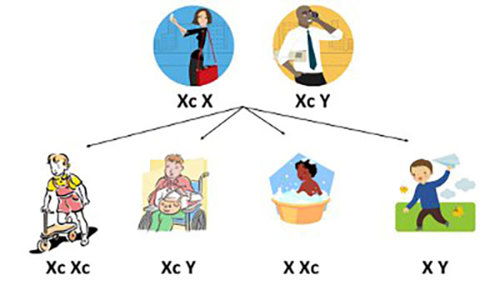
Why are all my sisters but none of my brothers colorblind?
December 12, 2013

- Related Topics:
- Color vision deficiency,
- X linked inheritance,
- Carrier
An undergraduate from Syria asks:
“My father is colorblind and my mom isn’t. Why are all my sisters but none of my brothers colorblind?”
This does seem like a rare, but possible, outcome. Boys are more likely to end up colorblind as compared to girls, but this is only true when you look at big populations. There are a couple of situations where boys and girls have an equal chance of being colorblind.
One is when both parents are colorblind. In this case, every child will most likely be colorblind too.
Since your mom isn’t colorblind and neither are you or your brothers, this situation doesn’t really apply to you though. Most likely your case is explained with a combination of your mom being a carrier and a bit of chance.
What I mean by carrier is that even though your mom isn’t colorblind herself, she has a hidden copy of it in her DNA that she can pass down to her kids. If a carrier for colorblindness like your mom has children with a colorblind man like your dad, then each child has a 50% chance of being colorblind. This doesn’t explain everything though because both boys and girls have a 50% chance of being colorblind.
So while this explains why your sisters are colorblind, it doesn’t really explain why your brothers aren’t. For that we need to introduce the element of blind luck.
Each child has a 50% chance of being a boy and a 50% chance of being a girl. In this case, each child also has a 50% chance of being colorblind and a 50% chance for being able to tell red and green apart. The two are unrelated.
So it just happened to shake out that the girls got mom’s colorblindness gene and the boys didn’t. (You’ll see why dad’s gene doesn’t matter in this case.) It could’ve been that no one ended up colorblind or everyone. Or all the other possible combinations in between. Your family just happened to end up with the girls colorblind and the boys not.
For the rest of the answer I thought I’d go into more detail about how colorblindness is passed on. As you’ll see, boys are more likely to end up colorblind most of the time. But occasionally, as in your family, boys and girls can sometimes have the same chance.

Packaging DNA
DNA has the instructions for making a living thing. Our DNA is stored in long pieces called chromosomes. Humans like us generally have 23 pairs of these really long pieces of DNA. We get one chromosome in each pair from our moms and one from our dads.
The pair we need to focus on is the one that determines whether you are a boy or a girl. Girls usually have a pair of X chromosomes while boys usually have an X and a Y.
The X chromosome is also where the gene with the instructions for the red-green receptor is located. This means that girls have two copies of this gene and boys have just one. And this is why more boys are colorblind than girls.
A gene is the instructions for one small part of you. Sometimes people inherit a gene that has a glitch in its instructions. This different version of the gene, called an allele, often makes something that no longer works correctly. This is what happens in colorblindness.
Colorblind people only have alleles of the red-green receptor gene that have the instructions for making a broken receptor. This is why they can’t tell red from green — they do not make any working receptors.
But one copy of a working gene makes enough receptor for a person to tell red from green. So people who have a working version and a broken one aren’t colorblind. Almost always these carriers are girls.
Remember, boys have one X chromosome while girls have two. This means boys have one copy of the red-green receptor gene and girls have two.
So if a boy gets a colorblindness gene from mom, he will for sure be colorblind because that is his only X and dad gives him a Y. A girl who gets a colorblind gene from mom won’t be colorblind if dad isn’t. Dad has one X that he can give to her and it has a working gene.
But if mom is a carrier and dad is colorblind, then daughters can be colorblind if they get a colorblind X from both mom and dad. This is probably what happened to your sisters.
Mom + Dad = Colorblind
Now we are ready to tackle your situation. If mom is a carrier, she has one X that can lead to colorblindness and one that doesn’t.
To make things easier to follow, we will call a “normal” X, X, and a colorblind X, Xc. So mom is X Xc — she has one of each type of X.
Dad is colorblind so his X is Xc. Since he is a man, this is his only X. He is Xc Y.
Here is what they might look like:

Notice mom has two X’s and dad has an X and a Y. Also, mom is a carrier, she has one “normal” X and one colorblind X, and that dad is colorblind because he only has a colorblind X.
Each child of theirs has a 50% chance of getting an X from mom and a 50% chance of getting an Xc. They also have a 50% chance of getting an Xc from dad and a 50% chance for getting a Y.
This means there are four different possible combinations and that the chance for any of them is the same. In other words, there is a 25% chance for each of the possible outcomes. Here they are:

For the first child, mom passed an Xc and so did dad. Since she has only Xc’s, she is colorblind. This is probably what happened to each of your sisters.
The second child got an Xc from mom and a Y from dad. He has only Xc’s and so is colorblind. None of your parents’ children ended up with this combination.
The third child got an X from mom and an Xc from dad. She has an X with a working red-green receptor gene so she is not colorblind. None of your parents’ children hit on this combination either.
The final child got an X from mom and a Y from dad. He has an X with a working red-green receptor gene and so isn’t colorblind. This is you and your brothers.
As I said, the chances for each combination are 25%. It just so happened that all of your sisters got an Xc from mom and all your brothers got an Xc from dad.
Blind luck probably determined that your sisters would be colorblind and your brothers wouldn’t. Blind luck and a copy bum copies of a red-green receptor gene.

Author: Dr. Barry Starr
Barry served as The Tech Geneticist from 2002-2018. He founded Ask-a-Geneticist, answered thousands of questions submitted by people from all around the world, and oversaw and edited all articles published during his tenure. AAG is part of the Stanford at The Tech program, which brings Stanford scientists to The Tech to answer questions for this site, as well as to run science activities with visitors at The Tech Interactive in downtown San Jose.
 Skip Navigation
Skip Navigation
